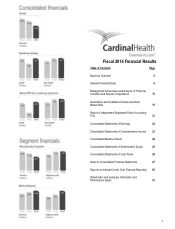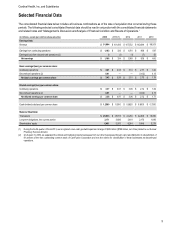Cardinal Health 2014 Annual Report Download - page 19
Download and view the complete annual report
Please find page 19 of the 2014 Cardinal Health annual report below. You can navigate through the pages in the report by either clicking on the pages listed below, or by using the keyword search tool below to find specific information within the annual report.Cardinal Health, Inc. and Subsidiaries
Management's Discussion and Analysis of Financial Condition
and Results of Operations
17
our financial position or results of operations. See Note 2 of the
“Notes to Consolidated Financial Statements” for additional
information regarding our acquisitions.
Goodwill and Other Intangible Assets
Purchased goodwill and intangible assets with indefinite lives
are not amortized, but instead are tested for impairment annually
or when indicators of impairment exist. Intangible assets with
finite lives, primarily customer relationships, trademarks and
patents, and non-compete agreements, are amortized over their
useful lives.
Goodwill impairment testing involves a comparison of the
estimated fair value of reporting units to the respective carrying
amount, which may be performed utilizing either a qualitative or
quantitative assessment. A reporting unit is defined as an
operating segment or one level below an operating segment
(also known as a component). If the estimated fair value exceeds
the carrying amount, then no impairment exists. If the carrying
amount exceeds the estimated fair value, then a second step
is performed to determine the amount of impairment, if any. An
impairment charge is the amount by which the carrying amount
of goodwill exceeds the estimated implied fair value of goodwill.
We estimate the implied fair value of goodwill as the excess of
the estimated fair value of the reporting unit over the estimated
fair value of its net tangible and identifiable intangible assets.
This is the same manner we use to recognize goodwill from a
business combination. Goodwill impairment testing involves
judgment, including the identification of reporting units, the
estimation of the fair value of each reporting unit and, if
necessary, the estimation of the implied fair value of goodwill.
We have two operating segments, which are the same as our
reportable segments: Pharmaceutical and Medical. These
operating segments are comprised of divisions (components),
for which discrete financial information is available. Components
are aggregated into reporting units for purposes of goodwill
impairment testing to the extent that they share similar economic
characteristics. Our reporting units are: Pharmaceutical
operating segment (excluding our Nuclear Pharmacy Services
division and Cardinal Health China - Pharmaceutical division);
Nuclear Pharmacy Services division; Cardinal Health China -
Pharmaceutical division; Medical operating segment (excluding
our Home division); and Home division.
Fair value can be determined using market, income or cost-
based approaches. Our determination of estimated fair value of
the reporting units is based on a combination of the income-
based and market-based approaches. Under the income-based
approach, we use a discounted cash flow model in which cash
flows anticipated over several future periods, plus a terminal
value at the end of that time horizon, are discounted to their
present value using an appropriate risk-adjusted rate of
return. We use our internal forecasts to estimate future cash
flows and include an estimate of long-term growth rates based
on our most recent views of the long-term outlook for each
reporting unit. Actual results may differ materially from those
used in our forecasts. We use discount rates that are
commensurate with the risks and uncertainty inherent in the
respective reporting units and in our internally-developed
forecasts. Discount rates used in our reporting unit valuations
ranged from 9 to 12 percent. Under the market-based approach,
we determine fair value by comparing our reporting units to
similar businesses or guideline companies whose securities are
actively traded in public markets. To further confirm fair value,
we compare the aggregate fair value of our reporting units to
our total market capitalization. Estimating the fair value of
reporting units requires the use of estimates and significant
judgments that are based on a number of factors including actual
operating results. The use of alternate estimates and
assumptions or changes in the industry or peer groups could
materially affect the determination of fair value for each reporting
unit and potentially result in goodwill impairment.
We performed annual impairment testing in fiscal 2014, 2013
and 2012 and, with the exception of our Nuclear Pharmacy
Services division in fiscal 2013, concluded that there were no
impairments of goodwill as the estimated fair value of each
reporting unit exceeded its carrying value. For our fiscal 2014,
2013 and 2012 testing, we elected to bypass the optional
qualitative assessment. With the exception of our Nuclear
Pharmacy Services division in fiscal 2013, if we were to alter
our impairment testing by increasing the discount rate in the
discounted cash flow analysis by 1 percent, there still would not
be any impairment indicated for any of these reporting units for
fiscal 2014, 2013 or 2012. As discussed further in Note 5 of the
“Notes to Consolidated Financial Statements”, during the fourth
quarter of fiscal 2013 we recognized an $829 million ($799
million, net of tax) non-cash goodwill impairment charge related
to our Nuclear Pharmacy Services division, which is included in
impairments and loss on disposal of assets in our consolidated
statements of earnings.
We review intangible assets with finite lives for impairment
whenever events or changes in circumstances indicate that the
related carrying amounts may not be recoverable. Determining
whether an impairment loss occurred requires a comparison of
the carrying amount to the sum of the undiscounted cash flows
expected to be generated by the asset.
Vendor Reserves
In the ordinary course of business, our vendors may dispute
deductions taken against payments otherwise due to them or
assert other billing disputes. These disputed transactions are
researched and resolved based upon our policy and findings of
the research performed. At any given time, there are outstanding
items in various stages of research and resolution. In
determining appropriate reserves for areas of exposure with our
vendors, we assess historical experience and current
outstanding claims. We have established various levels of
reserves based on the type of claim and status of review. Though
the transaction types are relatively consistent, we periodically
refine our methodology by updating the reserve estimate
























